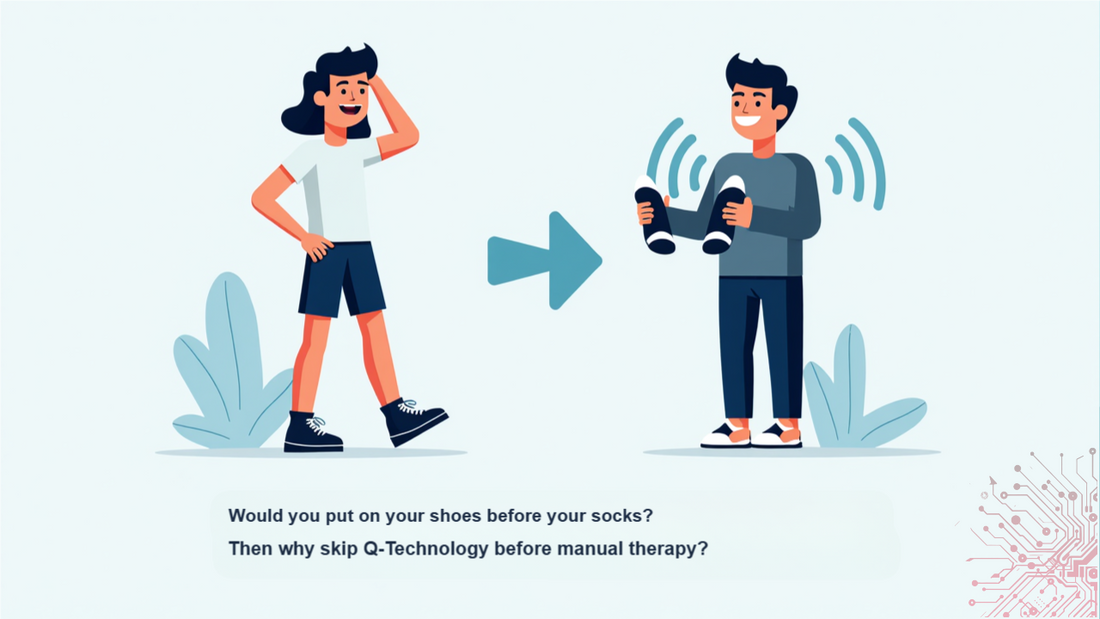
Why Q-Technology Should Always Come First
The art of putting on your socks before your shoes
In the world of therapy and rehabilitation, there's an unwritten but essential rule: order matters . You wouldn't put your shoes on before your socks, would you? So why apply manual or rehabilitation techniques before trying Q-Technology? This simple, logical, and incredibly effective approach could revolutionize the way you treat your patients' nervous and mechanical problems.
Q-Technology: Fine-tuning the nervous system
The nervous system is the conductor of everything we do. It controls muscles, joints, movement, and even pain perception. But sometimes it goes haywire, much like an out-of-tune piano. And guess what? Q-Technology is here to put everything back in harmony.
Thanks to its natural frequencies, like that of Schumann, Q-Technology acts directly on the nervous system to:
✅ Optimize nerve functions.
✅ Reduce unnecessary muscle tension.
✅ Free movement and reduce pain.
And here's the interesting thing: if a problem is of nervous origin, Q-Technology can often be enough on its own to solve it . No need for additional manipulations.
Test Q-Technology first: Save time and increase efficiency
Before using your manual or rehabilitation techniques, always start by having your patient wear the Q-Technology. Why?
1️⃣ If the problem is of nervous origin:
✔️ The technology will release tension, improve mobility, and reduce pain in seconds. You have an immediate solution, no need to go any further.
2️⃣ If the problem is mechanical or tissue:
✔️ If the pain persists or mobility doesn't improve, then you know the problem is structural. This is where your skills in joint mobilization, manual therapy, or fascia work come into play.
👉 By testing Q-Technology first, you optimize your interventions and avoid unnecessary manipulations.
Practical example: Your patient suffers from a frozen shoulder
A patient presents with shoulder pain and reduced mobility. Here's how to use Q-Technology to identify the cause:
🔹 Step 1: Have him wear the Q-Technology and observe the changes in pain and mobility.
🔹 Step 2: Analyze the results :
-
Does your shoulder move better and hurt less? 👉 Nerve problem. The technology has done its job. 🎉
- No improvement? 👉 Mechanical or tissue problem. It's time to move on to manual or rehabilitation techniques.
Why Q-Technology is essential
In addition to acting quickly on the nervous system, Q-Technology:
✔️ Harmonizes brain-body communication.
✔️ Reduces unnecessary tension, allowing muscles and joints to function better.
✔️ Simplifies your diagnosis: you quickly know if the problem is nervous or mechanical.
The mistake to avoid: Putting on your shoes before your socks
Applying a manual method without testing Q-Technology is like trying to fix a mechanical problem... while it's nervous. It's a waste of time for both you and your patient.
🧦 Q-Technology is a filter: it tells you whether you should intervene or let the nervous system do its work naturally.
A new standard in therapy
By integrating Q-Technology from the start of your consultations, you:
✅ Offer your patients a quick and natural solution .
✅ Avoid unnecessary manipulations .
✅ Gain in efficiency and credibility .
Conclusion: Always socks before shoes!
Q-Technology isn't just a tool; it's a revolution in pain and blockage management . So, before you whip out your manual techniques, give Q-Technology a try first. Your patients—and their nervous systems—will thank you.
And remember: everything is easier when you start in the right order… like putting on your socks before your shoes! 😉
💡 Do you want to become a Q-Technology partner? 👇
https://pages.q-store.fr/testeurs/firststep
